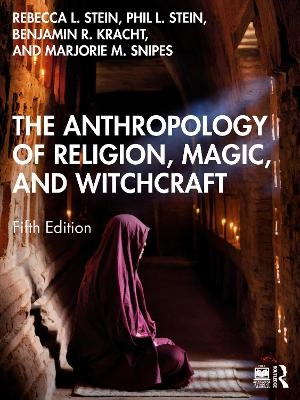
The Anthropology of Religion, Magic, and Witchcraft
Routledge (Verlag)
978-1-032-57299-4 (ISBN)
This concise and accessible textbook introduces students to the anthropological study of religion. It examines religious expression from a cross-cultural perspective and exposes students to the complexities of religion in small-scale and complex societies. The chapters incorporate key theoretical concepts and a wide range of ethnographic material. The fifth edition of The Anthropology of Religion, Magic, and Witchcraft offers:
• a revised introduction covering the foundations of the anthropology of religion, anthropological methods, and a push toward decolonizing the anthropology of religion,
• expanded coverage of symbols, healing, wizardry, and the intersections of religion with other social institutions,
• new case study material with examples drawn from around the globe, especially from Indigenous communities,
• marginalia in each chapter introducing provocative small-case examples related to the chapter—many of these can be used as prompts for further research, small in-class case studies, or examples for hands-on learning,
• a new chapter on religion and healing, especially useful for Anthropology programs without representation of four fields, as it provides a wider and more interdisciplinary application of the discipline,
• a consistent review of foundations from chapter to chapter, linking material and enabling students to connect what they are learning throughout the course, and
• further resources via a comprehensive companion website, including interactive activities, critical case studies, updated study questions, bibliographical suggestions (including video), and color images.
This is an essential guide for students encountering the anthropology of religion for the first time and also for those with an ongoing interest in this fascinating field.
Rebecca L. Stein is Professor of Anthropology and Department Chair at Los Angeles Valley College, USA. Philip L. Stein is Professor of Anthropology (Emeritus) at Los Angeles Pierce College, USA. He is a fellow of the American Anthropological Association and a past president of the Society for Anthropology in Community Colleges. Benjamin R. Kracht is Professor of Anthropology (Emeritus) at Northeastern State University in Tahlequah, Oklahoma. He is the author of Kiowa Belief and Ritual (2017), Religious Revitalization among the Kiowas: The Ghost Dance, Peyote, and Christianity (2018), and other books. Kracht has worked with the Kiowas for over 40 years and, more recently, has conducted fieldwork in Belize and New Mexico. Marjorie M. Snipes is Professor of Anthropology at University of West Georgia in Carrollton, Georgia. She has done extensive research in the Argentine Andes, as well as smaller research projects on religious change in the USA. Among her publications are The Intellectual Legacy of Victor and Edith Turner (2018) with Frank Salamone and OpenStax Introduction to Anthropology (2022) with Jennifer Hasty and David Lewis.
The Anthropological Study of Religion
The anthropological perspective
The concept of culture
Marginalia Cultural relativism and ethics
Four fields of anthropology
The holistic approach
The study of human societies
Ethnographic fieldwork
Box 1.1 First fieldwork
Marginalia Anthropology and ethics
The Fores of New Guinea: an ethnographic example
Two ways of viewing culture
Box 1.2 Fieldwork among the Kiowas
Viewing the world
Theoretical approaches to the study of religion
Evolutionary approaches to religion
The Marxist approach
The functional approach
The interpretive approach
The psychosocial approach
The bio-cognitive approach to religious behavior
Postmodernism
Attempts at defining religion
The domain of religion
The dependent and independent variables of religion
Table 1.1 Culture areas of the world
Table 1.2 Food-getting strategies
Conclusion
Summary
Study questions
Religious Symbols
What is a symbol?
Religious symbols
The swastika
The pentagram
Christian symbols
Box 2.1 The commodification of Zuni art
Sacred art and architecture
Maya architecture and hierophany
The meaning of color
Marginalia Commodification of color
Yoruba color terminology
Sacred space and sacred time
The Maya view of time
Box 2.2 The end of time
Rituals and calendars in modern world religions
Sacred time and space in Australia
Marginalia Animal symbols as mascots
Totemism and Dreamtime
The symbolism of music and dance
The symbolism of music
Marginalia Music and religion
Music in ritual
The symbolism of dance
Tattooing and other permanent body alterations
Conclusion
Summary
Study questions
Mythology
The nature of myths
Worldview
Stories of the supernatural
Myths and religion
Table 3.1 Forms of narrative
The nature of oral texts
Marginalia Oral tradition and the Shakers
Box 3.1 Genesis
Box 3.2 Gender and the Christian Bible
Understanding myths
Approaches to the analysis of myths
Searching for myth origins in the nineteenth century
Fieldwork and functional analysis
Structural analysis of myth
Box 3.3 The Gururumba creation story
Psychological symbols in myth
Common themes in myths
Origin myths
Marginalia Emergence myths
Box 3.4 The Navajo creation story: Diné Bahane’
Apocalyptic myths
Hero myths
Table 3.2 The monomyth in cinema: a sampling of common features
Conclusion
Summary
Study questions
Ritual
The basics of ritual performance
Prescriptive and situational rituals
Periodic and occasional rituals
A classification of rituals
Table 4.1 A classification of rituals
Technological rituals
Rites of intensification
Marginalia St. Francis rituals
Protective rituals
Divination rituals
Therapy rituals and healing
Navajo healing rites
Anti-therapy rituals
Ideological rituals
Offerings and sacrifices
Human sacrifice
Box 4.1 Morning star ceremony
Table 4.2 Skiri cosmology
Maya sacrifice and autosacrifice
Rites of passage
The structure of a rite of passage
Coming-of-age rituals
Transition and liminality
Table 4.3 Characteristics of liminality
Apache rite of passage
Secular rites of passage
Revitalization rituals
Alterations of the human body
Genital cutting
Marginalia Genital cutting in the U.S.
Pilgrimage as a religious ritual
Box 4.2 The hajj
The Huichol pilgrimage
Zuni quadrennial pilgrimages
Religious obligations
Tabu
Mana and tabu in Polynesia
Jewish food laws as religious ritual
Box 4.3 Menstrual tabus
Conclusion
Summary
Study questions
Altered States of Consciousness
The Nature of altered states of consciousness
Table 5.1 Characteristics of altered states of consciousness
Entering an altered state of consciousness
Table 5.2 Factors stimulating an altered state of consciousness
Fasting
Sacred pain
The biological basis of altered states of consciousness
Box 5.1 Altered states in Upper Paleolithic art
Ethnographic examples of altered states of consciousness
San healing rituals
The Sun Dance of the Cheyennes
The Holiness churches
Marginalia Christian snake-handlers
Hallucinogen-induced altered states of consciousness
Shamanism in South America
Hallucinogenic snuff among the Yanomamös
Tobacco in South America
Peyote in the Native American Church
Marijuana among the Rastafarians
Non-Indigenous uses of hallucinogens
Conclusion
Summary
Study questions
Religious Specialists
Shamans
Becoming a shaman
The shamanic role and rituals
Marginalia Shamanic visualizations
Siberian shamanism
Yakut shamanism
Korean shamanism
Pentecostal healers as shamans
Box 6.1 Clown doctors as shamans
Neoshamanism
Priests
Zuni priests
Okinawan priestesses
Eastern Orthodox priests
The monks on the Holy Mountain of Mt. Athos
Marginalia Religious icons
Other specialists
Kiowa owl prophets
Conclusion
Summary
Study questions
Magic and Divination
The nature of magic
Box 7.1 Why there is evil in the world
Magic and religion
Rules of magic
Homeopathic magic
Contagious magic
Marginalia Religious relics
Religious Relics and the Shakers
Magic in society
Magic in the Trobriand Islands
Learning magic
Trobriand garden magic
Magic among the Azandes
Kiowa power contests
Wiccan magic
Divination
Forms of divination
Table 7.1 A classification of methods of divination with examples
A survey of divination techniques
Noninspirational forms of divination
Box 7.2 I Ching: The Book of Changes
Inspirational forms of divination
Box 7.3 Spiritualism and séances
Ordeals
Astrology
Maya astronomy and astrology
Oracles of the Azandes
Divination in Ancient Greece: the Oracle at Delphi
Magical behavior and the human mind
Magical thinking
Why magic works
Conclusion
Summary
Study questions
Souls, Ghosts, and Death
Souls and Ancestors
Variation in the concept of the soul
Souls, death, and the afterlife
Examples of concepts of the soul
Yup’ik souls
Yanomamö spirits and souls
Hmong souls
The soul in Roman Catholicism
The soul in Hinduism and Buddhism
Ancestors
Yoruba ancestors
Beng ancestors and reincarnation
Tana Toraja ancestors and social death
Bodies and Souls
Ghosts
Box 8.1 A haunting in eastern Oklahoma
Ghosts around the world
Marginalia Ghosts in Southeast Asia
Dani ghosts
Bunyoro ghosts
The living dead: vampires and zombies
Vampires
Vampires in New England
Archaeological evidence of vampires in Poland
Haitian zombies
Zombies in contemporary culture
Marginalia Zombies as fear projections
Death rituals
Funeral rituals
Disposal of the body
Burial
The African Burial Ground
Secondary burials
Cremation
Mummification
Exposure
U.S. death rituals in the nineteenth century
U.S. funeral rituals today
Box 8.2 Roadside memorials
Days of Death
Halloween
Day of the Dead (Día de los Muertos) in Mexico and the Andes
Conclusion
Summary
Study questions
Gods and Spirits
Spirits
Marginalia Japanese kami
Dani views of the supernatural
Table 9.1 The supernatural world of the Danis
Guardian spirits and the Native American vision quest
Box 9.1 Kiowa vision quests
Jinn
Christian angels and demons
Box 9.2 Christian demonic exorcism in the United States
Gods
Types of gods
Table 9.2 The Roman gods and goddesses of agriculture
Gods and society
Gods reflect human behavior
Big gods
The gods of the Yorubas
Table 9.3 Some of the Yoruba orisha
The gods of the Ifugaos
Goddesses
Ishtar (Ancient Near East)
Isis (Ancient Egypt)
Kali (Hinduism)
Mary (Roman Catholic)
Monotheism: conceptions of god in Judaism, Christianity, and Islam
Judaism
Christianity
Islam
Marginalia Jains and ahimsa
Atheism
Conclusion
Summary
Study questions
Witchcraft, Sorcery, and Wizardry
Witchcraft, sorcery, and wizardry
Witchcraft among the Azandes
The Zande belief in witchcraft
The role of divination
An analysis of Zande witchcraft beliefs
Witchcraft among the Zunis
Sorcery among the Fores
Kiowa sorcery
Euro-American witchcraft beliefs
The connection with pagan religions
The witchcraze in Europe
The witchcraze in England and the United States
Marginalia Tituba
Functions of Euro-American witchcraft beliefs
Witches as women
Box 10.1 The evil eye
Modern-day witch hunts
Box 10.2 Satanism
Neo-paganism and revival
The Wiccan movement
Wiccan beliefs and rituals
Marginalia The Wiccan athame
The growing popularity and persecution of Wicca
Conclusion
Summary
Study questions
Magic, Medicine, and Religion
Explanatory models
Disease/illness dichotomy
Healers in the three sectors of healthcare
Box 11.1 African healers meet Western medicine
Personalistic and naturalistic medical systems
Personalistic medicine in small-scale societies
Table 11.1 Cross-cultural causes, prevention, and treatments
Marginalia Taqui Onqoy, the Dancing Sickness
Shamanistic techniques
Cholera in a Chinese village
Novocain magic
Plant spirits and medicines in personalistic medical systems
Humoral pathology and the rise of Western biomedicine
Humoral pathology in the North American colonies
Box 11.2 Ancient symbols in Western medicine
The smallpox blanket myth
Negotiating medical models in clinical settings
Faith and the biomedical approach
Spiritual architecture in the biomedical environment
The labyrinth
Religious specialists in biomedical environments
Conclusion
Summary
Study questions
The Search for New Meaning
Classic revitalization movements
Box 12.1 The Asbury revival
Haitian Vodou
History of Vodou
Vodou beliefs
Santería
Cargo cults
The Ghost Dance movements of 1869 and 1890
The Church of Jesus Christ of Latter-day Saints (Mormonism)
Modern-day cultural revival in Belize
New meaning in fundamentalism
Characteristics of fundamentalist groups
The Iranian Revolution
Box 12.2 The veil in Islam
The Arab Spring
High demand religions
The "cult" question
Characteristics of high demand religions
Mind control?
Examples of high demand religions
Branch Davidians (Students of the Seven Seals)
Unification Church
UFO religions
Heaven’s Gate
Raelians
Marginalia Edgar Cayce
New directions and revitalization in religion
"Spiritual but not religious"
Conclusion
Summary
Study questions
| Erscheinungsdatum | 31.08.2024 |
|---|---|
| Zusatzinfo | 14 Tables, black and white; 2 Line drawings, black and white; 112 Halftones, black and white; 114 Illustrations, black and white |
| Verlagsort | London |
| Sprache | englisch |
| Maße | 210 x 280 mm |
| Gewicht | 1140 g |
| Themenwelt | Sachbuch/Ratgeber ► Gesundheit / Leben / Psychologie ► Esoterik / Spiritualität |
| Geisteswissenschaften ► Religion / Theologie ► Weitere Religionen | |
| Sozialwissenschaften ► Ethnologie | |
| Sozialwissenschaften ► Soziologie | |
| ISBN-10 | 1-032-57299-X / 103257299X |
| ISBN-13 | 978-1-032-57299-4 / 9781032572994 |
| Zustand | Neuware |
| Haben Sie eine Frage zum Produkt? |
aus dem Bereich


